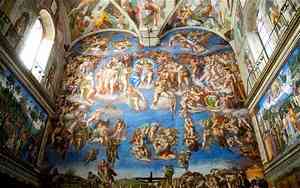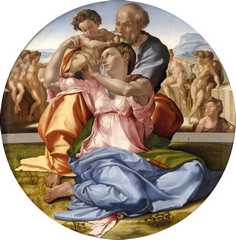


The Last Judgment Michelangelo 1536-41
Fresh paint in the pneuma of Arcadelt
Source:
The Telegraph
Born into the Renaissance about 1507 likely in Belgium, Jacques Arcadelt (also Jacob) continued the influence of the Franco-Flemish School into Italy. Johannes Gutenberg had long since printed his Latin Bible in 1455, contemporaneous with composers, Binchois and Ockeghem. Octavio Petrucci had introduced moveable type in a three-step process which enabled the printing of scores in 1501 (the Odhecaton). Gutenberg's printing press had fueled the Renaissance via the dissemination of humanist ideas holding classical Greece to be the ideal in all things from architecture to music. Petrucci's moveable type meant the wider distribution of scores than scribes could supply via quills one at a time in books compiled for only cathedrals or royalty. Arcadelt was born into the high Renaissance which Michelangelo Buonarroti, whom Arcadelt knew, had been supplying art since the 1490s, painting his 'Doni Tondo' ('Holy Family' also called 'Doni Madonna') not impossibly the same year that Arcadelt was born.

Doni Tondo Michelangelo c 1507
Source: Wikipedia
Probably composing by about 1520 as an adolescent, Arcadelt wrote largely secular madrigals and chansons. Secular music had been being written for the last four centuries since the troubadours in France. It had gained particularly powerful locomotion upon the gathering of the Burgundian School out of which the Franco Flemish school expanded to bring the musical Renaissance into which Arcadelt was born. Yet up to and well into the Renaissance sacred music of the Church had pretty much hogged the show for the last millennium. The Renaissance challenged the Church as the final word on music like no preceding period and Arcadelt was there to become a composer distinguished in secular rather than sacred works. Many a force beyond humanism was pressing on the Church at Arcadelt's time, the Papacy now shifting places with Holy Roman Emperors when it came to the real power in their alliance: everyone in Europe answered to the House of Habsburg except France and Venice. Emperors didn't give Venice grief since it held off the Ottoman Empire from its domains along the eastern coast of the Adriatic. Too, come the Protestant Reformation of 1517 which would further pare the Papacy down to size. Protestant England was a rigid place, but in Italy and France Arcadelt was free to pursue a lighter mode in contrast to the more somber atmospheres of either Catholic or Protestant music. They were likely more sober as well, if figure wine versus liquor.
Earliest history of Arcadelt who was an organist finds him already in Florence, Italy, as a young man in the twenties. In 1538 he was appointed a singer in the papal choir at St. Peter's Basilica in Rome. It was about that time that he might have written any of a number of 53 madrigals published in Antonio Gardano's 'Il primo libro de' madrigali a 4 voci' of 1539 [IMSLP]. Antonio was a heavyweight Venetian music publisher. No.1 of that volume is 'Il bianco e dolce cigno' ('The white and sweet swan') which text may or may not refer to death and orgasm analogously. The "swan song" which in music now refers to an artist's final composition or performance has its roots in ancient Greece wherein various sources have the swan singing not but before death or at least not so beautifully or happily. Comment as to the final song of the swan, or first if it is mute, is found in numerous poets since Chaucer's 'Parlement of Foules' ('Parliament of Fowls') sometime in the 14th century. Possible metaphorical reference between death and orgasm would relate to what is called Le Petite Mort [refs below]. 'Il bianco e dolce cigno' saw transcribing into the I-Fn MS Magl. XIX.99 in Florence in circa 1540. No.22 of 'Il primo libro de' madrigali a 4 voci' is 'Se la dura durezza in la mia donna dura' [text].
'Il bianco e dolce cigno' Secular madrigal a 4 by Jacques Arcadelt
'The white and sweet swan'
No.1 of 'Madrigali a 4 voci' pub 1539 MSS: c 1540
The Consort of Musicke directed by Anthony Rooley
'Se la dura durezza in la mia donna dura' Secular madrigal a 4 by Jacques Arcadelt
'If the stubborn inflexibility of my woman endures'
No.22 of 'Madrigali a 4 voci' pub 1539
The Hilliard Ensemble
Among other titles in Gardano's 'Il primo libro de' madrigali a 4 voci' of 1539 was No.23 that is 'Voi sapete'. Half a century later the painter, Caravaggio, completed 'The Lute Player' in three versions (Hermitage, Badminton, Wildenstein). The Hermitage and Badminton display part of a score identified to be from 'Voi Sapete'. This madrigal's text in French reads "Vous savez que je vous aime et vous adore...Je fus vôtre" ("You know I love you and adore you...I was yours") [Wikipedia]. Moffitt [refs below] has text rendered in Latin as 'Voi sapete ch'io v'amo anzi v'adoro / Ma non sapete gia, che per voi moro' ('You don't know that I'm in love with you, that I adore you' / But you don't yet know that I'm dying for you'). No.58 in Gardano's 'Madrigali a 4 voci' is 'Ahimè dov'è'l bel viso' which was copied into the I-Fn MS Magl. XIX.99 in Florence in circa 1540.

The Lute Player Caravaggio c 1596
Badminton version w scored melody from 'Voi Sapete' by Arcadelt
Source: ArtsViewer
'Voi sapete ch'io v'amo anzi v'adoro' Secular madrigal a 4 by Jacques Arcadelt
No.23 of 'Madrigali a 4 voci' pub 1539
Ensemble Kô directed by Ziya Tabassian
'Ahimè, dov'è'l bel viso' Secular madrigal a 4 by Jacques Arcadelt
'Alas, where is the beautiful face'
No.58 of 'Madrigali a 4 voci' pub 1539 MSS: c 1540
The Hilliard Ensemble
Arcadelt eventually moved up to the position of magister puerorum at the Sistine Chapel where he met Michelangelo, likely in 1542 the year after Michelangelo completed the 'The Last Judgment' on the altar wall of the Sistine. It was 1542 when Gardano published 'Il primo libro d'i madrigali a misura di breve' containing several madrigals by Arcadelt, No.3 being 'Da bei rami scendea'. Arcadelt remained at the Sistine Chapel until returning to France in 1551.
'Da bei rami scendea' Secular madrigal a 4 by Jacques Arcadelt
'Down from the branches falling'
No.3 of 'Il primo libro d'i madrigali a misura di breve' pub 1542
The Mirandola Ensemble directed by Scott Sandersfeld
During his latter career in France Arcadelt shifted from Italian madrigals to French chansons. His first employment was with Cardinal Charles de Guise of Lorraine in whose service he was when Le Roy and Ballard published 'Tiers livre de chansons' in Paris in 1554. That contained 22 chansons largely devoted to Arcadelt, No.11 of which was 'Margot, labourez les vignes' [text] which was probably a French folk song.
'Margot, labourez les vignes' Secular chanson a 4 by Jacques Arcadelt
'Margot, labor at the vines'
No.11 of 'Tiers livre de chansons' pub 1554
Ensemble D.E.U.M.
That Arcadelt was in the service of both Charles de Guise and King Henry II in 1557 is stated in a book of masses published by Le Roy and Ballard called 'Missae Tres Iacobo Arcadet' containing 'Missa Noe Noe', 'Missa Ave Regina Caelorum' and 'Missa de Beata Virgine'. The first two were parodies (imitations) of earlier motets by the same names composed by Jean Mouton and Andreas de Silva. The third was modeled after Josquin's 'Missa de Beata Virgine'.
'Missa Noe Noe' For 4 voices by Jacques Arcadelt
Pub in 'Missae Tres Iacobo Arcadet' in 1557
Capella Cordina
'Missa Ave regina caelorum' For 3-6 or 5 voices by Jacques Arcadelt
Pub in 'Missae Tres Iacobo Arcadet' in 1557
Josquin Capella directed by Meinolf Brüser
Arcadelt probably served King Charles IX upon the death of Henry in 1559. Arcadelt himself died on 14 October 1568. Known more for secular song than sacred music, Arcadelt left behind some 24 motets, 125 chansons, about 200 madrigals of certain attribution, 3 masses, some Lamentations of Jeremiah and a Magnificat.
Sources & References: Jacques Arcadelt:
VF History (notes)
Audio of Arcadelt:
Caravaggio (The Lute Player & Voi Sapete):
Keith Christiansen (Caravaggio Rediscovered: The Lute Player / Metropolitan Museum of Art 1990)
John F. Moffitt (Caravaggio in Context / McFarland 2004)
Compositions: Corpus: CPDL
Compositions: Individual:
Ahimè, dov'è'l bel viso (madrigal a 4 pub 1539)
Da bei rami scendea (madrigal a 4 pub 1542)
Il bianco e dolce cigno (madrigal a 4 pub 1539):
Margot, labourez les vignes (chanson a 4 pub 1554)
Missa Ave regina caelorum (a 3-6 or a 5 pub 1557)
MSS (manuscripts): DIAMM
La Petite Mort (little death: orgasm):
Publishers & Publishing:
Antonio Gardano (1509-69)
Missae Tres Iacobo Arcadet (1557)
Recordings of Arcadelt: Catalogs:
Discogs MusicBrainz Naxos Presto RYM
Scores / Sheet Music:
IMSLP Musicalics Opera Omnia (CMM Editions)
Further Reading:
Death & Sexuality (: Le Petite Mort):
John Martin Fischer (The Metaphysics of Death / Stanford U Press 1993)
Hudith Roof (Come As You Are / Columbia U Press 1996)
Publishing (early music printing): HOASM
Bibliography:
Rob van Haarlem / J. S. Mackenzie Owen (The 'Missa de beata Virgine' / 1975)
Authority Search: BnF VIAF World Cat
Other Profiles:
hmrproject (at) aol (dot) com